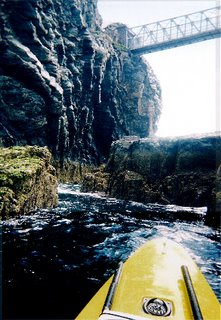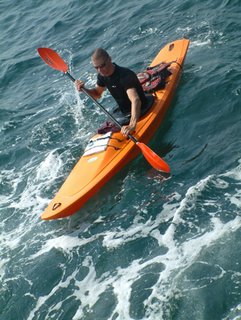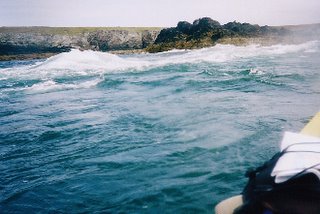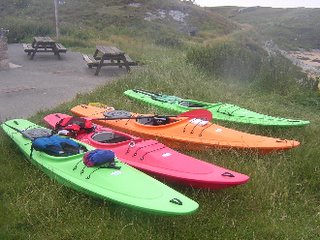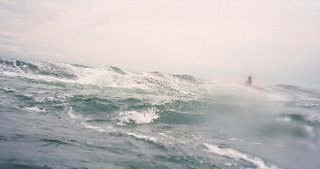Saturday, June 03, 2006
Thursday, March 16, 2006
Off to Greece soon!
 Well, we are off to Greece! In mid April my girlfriend and I are off for the summer - to the lovely island of Milos (I know, somebody has to do it!).
Well, we are off to Greece! In mid April my girlfriend and I are off for the summer - to the lovely island of Milos (I know, somebody has to do it!).I will be helping out at Sea Kayak Greece, run by Rod Feltman. Rod runs guided kayaking trips on the island (day trips through to full multi-day expeditions).
We are taking the Beetle, one Rockhopper, a surf kayak and my girlfreind's Romany Explorer. The trip to Milos will be via Plymouth, Santander, Barcelona, Nice, Sardinia, Athens, then Milos.
We are both very excited about the trip and our time in Greece. I will be taking every opportunity I can to put the Rockhopper through its paces (yes they DO get big seas and surf in the Med). I am also looking forward to testing out a new camcorder + mini waterproof lens system - hopefully some good video footage on the way!
Of course this blog will be an ideal opportunity to let you all know how it's going.
Check www.seakayakgreece.com
Wednesday, March 15, 2006
Front buoyancy
The RH340 has a space up front fore of the small footrest "tank". It is essential that this space is fitted with extra buoyancy - it helps a rescuer to empty your kayak and enables you to successfully complete a re-entry and roll. Although an airbag is the usual addition to the space these are expensive and they do have a tendency to deflate after a while (and it is impossible to see what is happening in there so you do not always know a deflaton has taken place). On my Rockhoppers I have put three cheap plastic footballs in this space (£2 or £3 each). They will not deflate unless they burst. You do have to pull the foitrest right up as close to the seat as possible to get them in but they do squash through the gap... Julian.
Monday, March 06, 2006
RH340 review by Nick Cunliffe
 Nick Cunliffe: Director of Surflines (kayak sales and rental), previously Head of Kayaking at the National Watersports Centre, Plas Menai.
Nick Cunliffe: Director of Surflines (kayak sales and rental), previously Head of Kayaking at the National Watersports Centre, Plas Menai.I first set eyes on the RH340 in the summer of 2003 when Julian Patrick, the boat’s designer and BLUEsky owner, brought two prototypes to our kayaking centre in Llanberis. I was intrigued by the unusual lines – the boat’s flat hull, pronounced bow rocker and defined rails were more reminiscent of a surfboard than a sea kayak. They certainly grabbed my attention, and I was delighted to be offered a loan of the boats for extended “sea trials”.
Julian emphasised the ethos behind the RH340 – a boat dedicated to “playing the sea”, exploring the impact-zone between open ocean and rocky coastline, at home in the surf, a capable performer in tide races, and above all a seaworthy craft. I privately mused that such a design brief was a tall order for one boat. My doubts evaporated with each trip in the boat.
For a couple of months the RH340 was a regular guest on our canoe trailer, typically travelling to Trearddur bay on Anglesey’s west coast. There, in a variety of conditions, the kayak proved to be a stable, manoeuvrable platform for coastal exploration. We were impressed with its ability to keep pace with traditional sea kayaks over moderate distances, especially with the retractable skeg down to assist tracking. With the skeg up, the boat was nimble enough to turn in its own length with only a couple of sweeps – and above all, it inspired confidence when paddling through waves. Surf landings were a dream, the pronounced rocker and flared bow giving a dry ride into the beach.
Perhaps the most unexpected revelation was the feedback we received from complete novices, who all spoke positively about their first experiences in the RH340. Despite Julian’s stated aim to design a boat for playing in the rough stuff, many of the design characteristics that made the boat suitable for those conditions also combined to produce a kayak that could be described as the “ultimate beginners’ boat”. Plenty of volume and a relatively flat hull for stability, but not an excess size; reasonable turn of speed and excellent tracking (skeg down), a piece of cake to manoeuvre (skeg up); and a reliable, predictable ride in wind and waves. My conversion was complete as I sat off Penrhyn Mawr with two novice paddlers, having snaked along the coast from Porth Dafarch, exploring every cave along the way. Granted, the weather was perfect with no tide running, but as we gazed north toward South Stack lighthouse I struggled to think of another craft that would have allowed me to offer this experience to newcomers, with such ease.
One uncertainty remained, however; other than the occasional lap of the bay, I hadn’t paddled it for myself! How would it perform in the rough stuff? Our annual trip to Pembroke beckoned, and the RH340 prototypes were not going to miss out…Ramsey Sound on spring tides is a fierce place for paddlers. The north-going flood tide is squeezed between St David’s Head and Ramsey Island, producing a powerful eight-knot stream through the half-mile wide channel. Extending half way into the channel from the Ramsey side is a reef of rocks, covered or exposed according to the height of the tide. This notorious area, known as “The Bitches” is a significant hazard to small boats as the tidal stream pours through in a maelstrom of waves, boils and holes. For skilled paddlers, however, it is a playground of the highest quality – and an excellent test for the RH340’s top-end performance.
A small team assembled in St David’s early one October morning. Our second “Rock Hopping Pilot” was Duncan – a capable sea paddler, but not too sure about the surging tides of Ramsey Sound. An early-morning launch from the lifeboat station at St. Justinian gave us an easy paddle up the eddy to the headland opposite the Bitches. Crossing the early flood tide, we ferry-glided in behind the first of the rocks then made a series of crosses to reach the sanctuary of Ramsey’s only harbour. En route, the RH340s sped smoothly across the rippled water, gliding across the strengthening eddy lines with little fuss. Duncan, despite his unfamiliarity with the place, looked (and felt) comfortable throughout the crossing to the island.
As the tide race gathered speed, the famous features of the Bitches became apparent. With waves and holes to surf, fast crosses to make and rocky gullies to negotiate, this aquatic playground made an excellent test of the boat’s performance. I was reminded of Julian’s words – “It’s a rock hopping kayak, not an out-and-out surf boat” – as I accelerated up the eddy toward the Big Wave. To my delight, the RH340 punched positively through the eddy line, maintained it speed toward the peak, and surged forward into the trough of the wave. No problems with boat speed! A few laps of the eddy and I was getting it wired - blast across the flat section to the wave, stall the boat on the peak and gently surge down the wave face. The RH340 responded to weight shifts and was far easier to turn on the wave than any sea kayak I had previously paddled. Not quite the surfing performance I’d expect from a more dedicated boat, but that’s not the point: the RH340’s crossover design makes it a fun boat in a wide variety of conditions.
We crossed back to The Hole for sterner test of the boat’s manoeuvrability. Normally the territory of short boats, this surging wave offered little margin for error in a 3.5 metre boat. Nevertheless, the RH340 bounced nimbly between the rocks, cutting across the eddy lines in a passable impression of a small river boat. Clearly, cutbacks were slower and less dynamic, but the boat passed its white water test with flying colours. One highlight, as the swell surged: the wave steepened sufficiently to bury the bow - no mean feat, in this well-rockered craft. As the stern came up, I stood to attention on the footrest for a perfect Old School Pop-Out. Fantastic!Duncan, meanwhile, had been creating his own fun among the eddy-lines downstream. His growing confidence was due in no small part to the predictable performance the boat offered. Stability and seaworthiness were put to the test on the way home, as we bounced down the impressive wave train back to St. Justinian. Again, the boat’s speed advantage over our companion river boats emphasised the all-round performance of our rock hoppers.On reflection, the RH340 packs a great deal of fun into one single design. For paddlers looking for a stable seaworthy kayak, capable of travelling in comfort, with a play performance surpassing any current sea kayak, they need look no further. The dedicated rock hopper and tide race junkie has a boat that will expand horizons and give you the biggest grin on the water!
Stainless fins
 New stainless steel fins now available.
New stainless steel fins now available.Shiny and rock hard!
Order from www.teksport.com
Why do you need fins? Well you don't
"need" them - they do improve tracking
though and this helps when surfing waves
(surfing, following seas, overfalls).



